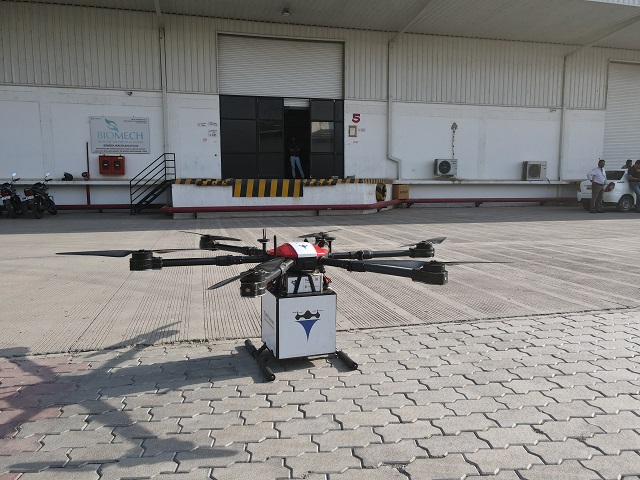The Rise of the Drone Industry: Evolving Roles of Cutting-Edge Technologies in Revolutionizing the Drone Industry with TSAW Drones

CXOToday has engaged in an exclusive interview withMr. Rimanshu Pandey, Co-Founder and CTO, TSAW Drones.
Brief about TSAW Drones and how it is contributing to the drone technology industry.
I, Rimanshu Pandey, alongside my Co-founder Kishan Tiwari, Co-founded TSAW Drones in 2019, with our headquarter based in Research and Innovation Park, IIT Delhi. Over the years, we have made significant contributions to both drone technology as well as drone logistics sector. Our drone logistics subsidiary, DRONECO, has successfully completed over 8204+ package deliveries, revolutionizing logistics, especially in last-mile e-commerce operations. We’ve pioneered proprietary software tools like GTM (Ground Traffic Management), GCS (Ground Control System), and UTM (Unmanned Traffic Management) to enable safe tracking of drones beyond visual line of sight (BVLOS). Our commitment to innovation is reflected in ongoing research and development efforts, focusing on improving battery technology and exploring novel drone applications. TSAW Drones is at the forefront of advocating safety and compliance, actively engaging with aviation authorities and implementing cutting-edge security solutions, including encryption, geofencing, and airspace management.

How are new technologies improving the flight time and endurance of drones?
Advancements in various aspects of drone technology are consistently enhancing their flight time and endurance. These improvements are driven by progress in materials, batteries, propulsion systems, power management, software, and the exploration of alternative energy sources. As these technological domains evolve, we anticipate substantial strides in drone endurance, expanding the horizons of industries and applications that heavily depend on these remarkable aerial devices. With extended flight durations, drones are poised to become even more indispensable in our rapidly evolving world.
Can you explain how AI is making drones smarter and more autonomous?
As someone deeply involved in this field, it’s fascinating to witness how Artificial Intelligence (AI) is revolutionizing drones, making them notably smarter and more self-reliant. AI has enabled drones to tackle an array of tasks with unprecedented efficiency and effectiveness. It starts with autonomous navigation, where AI algorithms facilitate obstacle avoidance, real-time route planning, and in-flight path adjustments, enhancing their ability to operate independently. AI-driven object recognition, particularly through deep learning models like Convolutional Neural Networks (CNNs), empowers drones to identify and track objects, proving invaluable in scenarios such as search and rescue missions and wildlife monitoring. These drones are also equipped with path-planning algorithms that adapt to changing conditions, ensuring obstacle-free journeys. In industrial contexts, AI-equipped drones autonomously inspect structures, detecting defects through computer vision and machine learning. Additionally, AI optimizes delivery routes, improves security and surveillance capabilities, and even enhances energy efficiency, prolonging flight times. The future promises even greater advancements, cementing drones’ role as intelligent, autonomous aerial tools across a multitude of industries and applications.
What recent innovations have a bearing on improving drone navigation?
The recent innovations in drone navigation are driving the industry forward, enabling drones to operate more safely, efficiently, and autonomously in a wide range of applications. Advanced GPS and GNSS technology, SLAM algorithms, AI and machine learning, 5G connectivity, and sense and avoid systems are just a few examples of the exciting developments that have a significant bearing on improving drone navigation. As these technologies continue to evolve, we can expect drones to become even more versatile and capable, unlocking new possibilities and expanding their role in our daily lives.

How is 5G technology changing the way drones transmit and receive data?
5G technology is transforming the capabilities of drones by providing higher data rates, low latency, improved reliability, network customization, and enhanced security. These advancements are enabling new use cases and expanding the potential of drones across various industries. However, it’s important to note that the widespread adoption of 5G for drone applications may also bring about regulatory and privacy considerations that need to be addressed as the technology continues to evolve.
How do collision avoidance technologies improve the reliability and safety of drones?
Collision avoidance technologies are instrumental in elevating both the safety and reliability of drones. By equipping drones with advanced sensors like LiDAR, radar, and computer vision, these systems provide real-time environmental data. Algorithms process this data to detect obstacles or potential collisions in the drone’s flight path. Consequently, the drone can make rapid, informed decisions, autonomously adjusting its course to avoid obstacles or halt operations if necessary. This enhances reliability by minimizing the risk of accidents, crashes, or damage to the drone itself. Moreover, these technologies play a pivotal role in ensuring the safety of people, property, and other aircraft in the vicinity. This heightened level of safety is crucial for expanding drone applications, particularly in urban environments, critical infrastructure inspections, and delivery services.
Are virtual reality technologies helping to teach drone pilots?
Virtual reality technologies have emerged as valuable tools for training drone pilots. They offer a safe, cost-effective, and immersive way to develop the skills and confidence necessary for operating drones in various industries. While there are challenges and considerations associated with VR-based training, its ability to replicate real-world scenarios and provide immediate feedback makes it a promising avenue for the future of drone pilot education. Furthermore, VR training can be customized to suit different skill levels, from beginners to advanced pilots, making it an invaluable tool in the education and skill development of drone operators.
How are drone technologies facilitating the easing of logistics, agriculture, and other sectors?
Drone technologies are revolutionizing logistics, agriculture, and various other sectors by providing innovative solutions that enhance efficiency and productivity. In logistics, drones are streamlining last-mile delivery, reducing delivery times, and lowering operational costs. They are particularly valuable in remote or hard-to-reach areas, ensuring timely deliveries of goods and medical supplies. In agriculture, drones equipped with cameras and sensors are transforming precision farming. They monitor crop health, optimize irrigation, and identify areas needing attention, ultimately increasing crop yields while minimizing resource usage. Drones also aid in pest control and can even perform crop spraying, reducing the need for manual labor and pesticides. Beyond these sectors, drones are used for surveying and mapping, providing high-resolution aerial imagery for construction, mining, and land management. In disaster management, they assess damage and locate survivors quickly. In the energy sector, drones inspect critical infrastructure like power lines and wind turbines, enhancing safety and reducing downtime. In years to come, drones’ potential to revolutionize numerous industries grows, promising increased efficiency, cost savings, and improved outcomes across the board.








